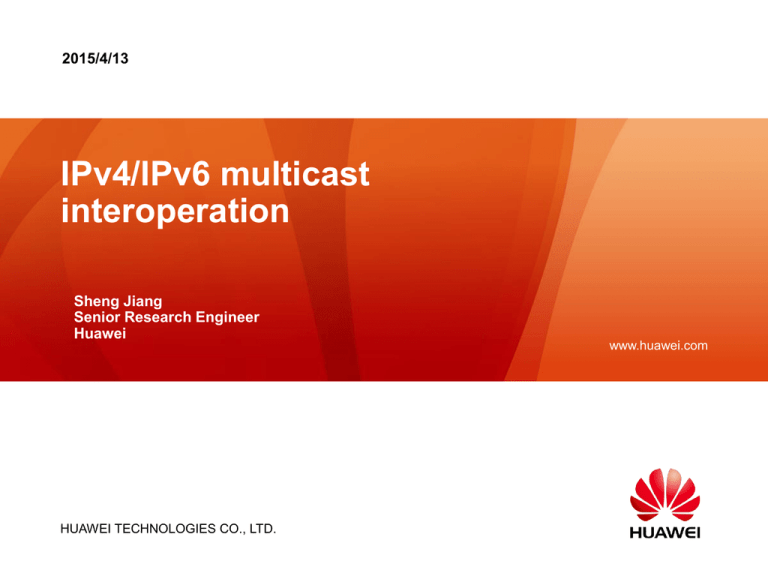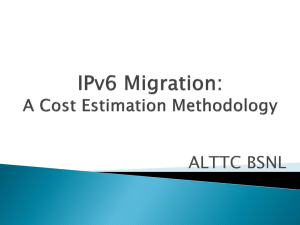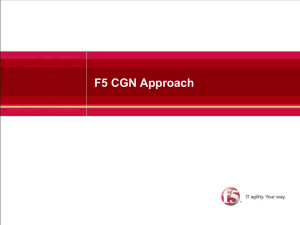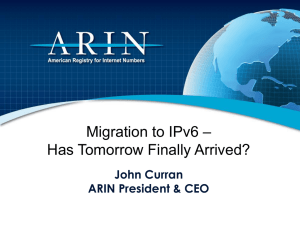Slides
advertisement

2015/4/13 IPv4/IPv6 multicast interoperation Sheng Jiang Senior Research Engineer Huawei HUAWEI TECHNOLOGIES CO., LTD. www.huawei.com Outlines • IPv4/IPv6 Transition Trends • Brief Multicast Introduction • Basic IPv4/IPv6 Multicast Interoperation Mechanisms • Multicast Deployment in 46 Transition Scenarios HUAWEI TECHNOLOGIES CO., LTD. Huawei Confidential Page 2 IPv6 Speed up - IPv4 Address Exhaustion • Public IPv4 address is expected to be exhausted – IANA Unallocated Address Pool: 01-Aug2011 – RIR Unallocated Address Pool: 04-Mar2012 – Exhaustion prediction on June, 2010: – http://www.potaroo.net/tools/ipv4/index.h tml • More and more devices will be connected to the Internet. More and more addresses are needed • IPv6 is the only right answer for the address exhaustion issue • IPv4/IPv6 will co-exist for a long period. 15 year + HUAWEI TECHNOLOGIES CO., LTD. Huawei Confidential Page 3 Major technology choices RFC 6036 “Emerging Service Provider Scenarios for IPv6 Deployment” 93% choose a dual stack routing backbone 40% run/plan a 6to4 relay 17% run/plan a Teredo server Dual stack backbone + supplement transition mechanism are majority 77% run/plan no equipment dedicated to IPv6 (different) 77% do not see IPv6 as an opportunity to restructure topology HUAWEI TECHNOLOGIES CO., LTD. Dual stack routing backbone 93% 6 to 4 relay 40% Teredo server 17% Huawei Confidential Page 4 IPv4-IPv6 interworking 57% of ISPs don't expect IPv6-only customers Mobile operators are certain they will have millions 5 ISPs report customers who explicitly refused to consider IPv6 How long will users run IPv4-only applications? Need Interworking The most frequent answer is "more than ten years" Is IPv6-IPv4 interworking at the the IP layer needed? 90% say yes 30% plan NAT-PT or NAT64 23% rely on dual stack the others are in duh! space HUAWEI TECHNOLOGIES CO., LTD. Huawei Confidential Page 5 IPv4/IPv6 Transition Technologies Choice Global transport backhaul network must be dual stack European ISps prefer jump to IPv6, like DS-Lite NA ISPs prefer IPv4-based mechanism, like 6rd or incremental CGN JP, CN may choose Dual stack Observation only – trends for now Still new transition technologies proposed, like host-based 6a44, or Teredo extension Europe DS-Lite 6rd, incremental CGN Asia Dual stack North America Africa South America Oceania HUAWEI TECHNOLOGIES CO., LTD. Huawei Confidential Page 6 Outlines • IPv4/IPv6 Transition Trends • Brief Multicast Introduction • Basic IPv4/IPv6 Multicast Interoperation Mechanisms • Multicast Deployment in 46 Transition Scenarios HUAWEI TECHNOLOGIES CO., LTD. Huawei Confidential Page 7 Multicast Brief Intro Multicast is a technique for one-tomany communication over an IPv6 infrastructure in a network. It is often employed for streaming media and Internet television applications. In multicast, routers create optimal distribution paths for datagrams sent to a multicast destination address spanning tree in real-time. Multicast uses network infrastructure efficiently by requiring the source to send a packet only once, even if it needs to be delivered to a large number of receivers. It is particularly suitable for the scenarios that involve large scale receivers. HUAWEI TECHNOLOGIES CO., LTD. Huawei Confidential Page 8 Multicast Architecture in IPv4 & IPv6 IPTV Service Platform Multicast over Ethernet VLAN Multicast tree Multicast to End-user Multicast Source Middleware NS M EP G PC TV STB Metro Ethernet IP Core CPE BNG Multicast Stream No CH CH CH po . √ 1 X 2 √ 3 rt1 po X √ X rt2 MLD/IGMP Report Multicast for IPv4 PIM v4 IGMPv3 Multicast for IPv6 PIM v6 MLDv2 IGMPv3 MLDv2 In IPv6/IPv4 multicast, routers use multicast routing protocol, such as PIM, to construct multicast tree for multicast routing table to forward the multicast datagrams. In IPv6/IPv4 multicast, routers use multicast group management protocol, such as IGMPv3 for IPv4 and MLDv2 for IPv6, to manage multicast members, and set up and maintain member relationships between hosts and the multicast router to which the hosts are directly connected. HUAWEI TECHNOLOGIES CO., LTD. Huawei Confidential Page 9 Outlines • IPv4/IPv6 Transition Trends • Brief Multicast Introduction • Basic IPv4/IPv6 Multicast Interoperation Mechanisms • Multicast Deployment in 46 Transition Scenarios HUAWEI TECHNOLOGIES CO., LTD. Huawei Confidential Page 10 IPv4/IPv6 Multicast Interoperation Difficulties/Considerations How to allow IPv6 terminals to access a IPv4 multicast source? How to allow IPv4 terminals to access a new IPv6 multicast source? Avoid carrying each IPTV channel twice in IPv4/IPv6 (support nationally) Connecting IPv4 terminals and IPv4 multicast source through IPv6 networks Connecting IPv6 terminals and IPv6 multicast source through IPv4 networks HUAWEI TECHNOLOGIES CO., LTD. Huawei Confidential Page 11 IPv4/IPv6 packet-based multicast translation V4 MSource Mapping between IPv4 and IPv6 Embedding IPv4 multicast addresses into IPv6 Translating IPv6 multicast addresses into IPv4 Every packets need to be transformed IPv4 Network Translator Issues: RFC2766 NAT-PT has been moved into Historic Status by RFC4966 IETF has not yet produced new translation standard for multicast (NAT46 and NAT64 are separated) IPv6 Network IPv6 host Part of multicast tree is invisible HUAWEI TECHNOLOGIES CO., LTD. Huawei Confidential Page 12 IPv4/IPv6 multicast proxy (ALG) Mainly based on content cache concept The proxy retires the content data from IPvX network, caches the data, and multicasts the data in IPvY network V4 MSource IPv4 Network It acts as a multicast leaf in the IPvX network where the data source locates It also acts as a multicast source in IPvY network where the multicast client locates Two independent multicast trees Within the proxy, multicast addresses or trees are mapped Proxy IPv6 Network No necessary need IETF standard IPv6 host Implementation or deployment level mechanism HUAWEI TECHNOLOGIES CO., LTD. Huawei Confidential Page 13 Multicast Tunnel (part of the Tree) The motivation for this method is to become fully functional IPv6 nodes by using an IPv4 domain that supports IPv4 multicast as their virtual local link. It uses IPv4 multicast as a "virtual Ethernet“. Auto-tunnel transported IPv6 multicast packet across IPv4 multicast area Encapsulate IPv6 multicast packets into IPv4 multicast tree Multicast Stream IPV4 Decapsulate tunnel packets to IPv6 multicast tree Multicast address mappingAdministratively Scoped IP v4 multicast map to IPv6 multicast address MLD or PIM For IPv4, instead IPv4 multicast, Point-to-point tunnel or last hop pushing is possible, but high cost HUAWEI TECHNOLOGIES CO., LTD. V6 MSource MLD or PIM V6 Terminals Huawei Confidential IPv4 PIM Multicast Stream Page 14 Outlines • IPv4/IPv6 Transition Trends • Brief Multicast Introduction • Basic IPv4/IPv6 Multicast Interoperation Mechanisms • Multicast Deployment in 46 Transition Scenarios HUAWEI TECHNOLOGIES CO., LTD. Huawei Confidential Page 15 Dual Stack Suitable Scenarios: new dual-stack network • Advantage:Both IPv6 and IPv4 services are native. Minimize the inter-communication between IPv6 and IPv4 • Require all forwarding devices, include CPE to be upgraded V4 MSource V6 MSource 46 MProxy or MTranslator Dual Stack Metro Net Two parallel forwarding plate • native IPv6 services • IPv4 services remain the same Carrier may provide private IPv4 address to CPE and terminals IPv4 HG • Source and Terminals should be in the same address space in order to avoid NAT44 If no IPv6 source, 46 multicast proxy or translator is needed HUAWEI TECHNOLOGIES CO., LTD. IPv6 Dual Stack V4 V6 Terminals Huawei Confidential V4 V 6 Terminals Page 16 IPv4 Network Infrastructure Suitable Scenarios: IPv4 Network Infrastructure 6rd (RFC5969) or Incremental CGN (ietf-v6ops-incremental-cgn) V4 MSource V6 MSource • Advantage:most of network devices remain unmodified, minimum investment, Deployment quick and simple • Require new CPEs and an tunnel end devices IPv4 46 MProxy or MTranslator IPv6 CGN 4/4 Translation IPv4 forwarding still dominate 6in4 TUNNEL IPV4 • IPv4 services remain the same 6in4 TUNNEL • Part of IPv6 multicast tree is encapsulated into 6over4 tunnels IPv4 BRAS(IPv4) BRAS (IPv4) NAT44 Carrier may provide private IPv4 address to CPE and terminals CPE CPE • Source and Terminals should be in the same address space in order to avoid NAT44 If no IPv6 source, 46 multicast proxy or translator is needed HUAWEI TECHNOLOGIES CO., LTD. V4(Private Address) V6 V4(Public Address) Terminals Huawei Confidential V6 Terminals Page 17 IPv6 Network Infrastructure DS-Lite (ietf-softwire-dual-stack-lite) Suitable Scenarios: IPv6 Network Infrastructure • Advantage:IPv6-only network is simple and easy for management, provide IPv4 services too • Do not require any public IPv4 addresses • Require all forwarding devices, include CPE to be upgraded Mainly IPv6 traffics, continuously provide IPv4 access services V4 MSource IPv4 CGN/ Large Scale NAT 46 MProxy or MTranslator HUAWEI TECHNOLOGIES CO., LTD. IPv6 4/4 Translation IPV6 BNG (IPv6) If no IPv4 source, 64 multicast proxy or translator is needed If no IPv6 source, 46 multicast proxy or translator is needed 46 MProxy or MTranslator CGN 4in6 tunnel • native IPv6 services • Part of IPv4 multicast tree is encapsulated into 4over6 tunnels V6 MSource BNG (IPv6) CPE V4(Private Address) Huawei Confidential V6 CPE v4 Page 18 v6 IPv6 Era is coming IPv6 Trail IPv6 Widely Deployment IPv4 Quit IPv6 develop curve IPv6/IPv4 Inter-communication ● IPv6 commercial usage ● IPv4 Quit IPv6 & IPv4 Co-existence 5~15 Years 2010 The later IPv6 deployment starts, the higher the overall network transition cost is ISPs face both IPv6 transition and IPv4 address shortage problems. The combination of mechanisms from two categories is needed HUAWEI TECHNOLOGIES CO., LTD. Huawei Confidential Page 19 Thank you www.huawei.com








